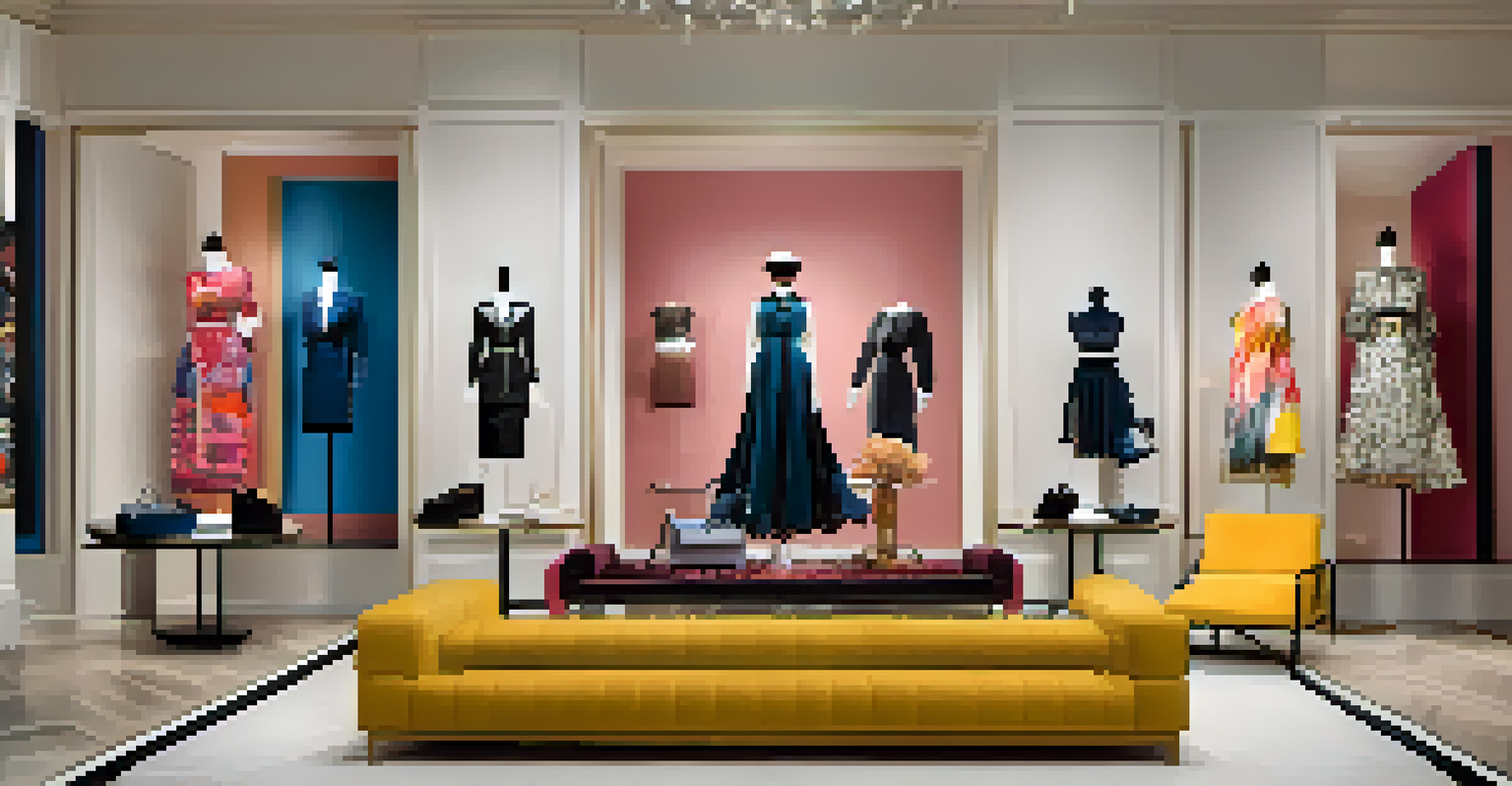Historical Fashion Trends: Lessons for Future Predictions

Fashion Cycles: The Rebirth of Styles Through Time
Fashion is like a cycle, often revisiting styles from decades past. Think of flared jeans making a comeback; they were a hit in the 70s, then resurfaced in the 2000s. This cyclical nature shows that trends often have a way of returning, albeit with modern twists.
Fashion is the armor to survive the reality of everyday life.
Understanding these cycles helps fashion enthusiasts anticipate what might come next. Designers frequently draw inspiration from previous eras, reinterpreting old styles to fit contemporary tastes. This blending of past and present creates a dynamic landscape where trends evolve yet remain familiar.
For example, the resurgence of 90s grunge has been updated with sustainable fabrics, marrying nostalgia with modern values. By studying historical fashion, we can better predict future trends that resonate with current societal shifts.
Cultural Influences: How Events Shape Fashion
Fashion doesn't exist in a vacuum; it's deeply intertwined with cultural events and societal changes. For instance, the flapper dresses of the 1920s reflected women's newfound freedoms, while the 1960s saw bold colors and patterns that mirrored social upheaval. These styles were more than just clothing; they were statements of identity and change.

As we look to the future, understanding these cultural contexts will be crucial. Just as the past has shown, significant events—like technological advances or social movements—will likely influence upcoming trends. Designers who tap into these cultural narratives can create pieces that resonate on a deeper level.
Fashion Cycles Repeat Over Time
Trends often resurface with modern twists, reflecting a cyclical nature that allows fashion enthusiasts to anticipate future styles.
For instance, the current focus on sustainability in fashion is a response to climate change awareness. Future trends may echo this sentiment, bringing forth innovative designs that prioritize eco-friendliness while still being stylish.
The Role of Technology in Shaping Fashion Trends
Technology has always played a pivotal role in fashion, from the invention of the sewing machine to today's 3D printing capabilities. These advancements not only change how clothes are made but also how they're marketed and sold. The rise of online shopping and social media platforms has transformed the way trends spread.
Sustainability is no longer about doing less harm. It's about doing more good.
In the future, we can expect even more technological integration, possibly with virtual reality (VR) and augmented reality (AR) changing the shopping experience. Imagine trying on clothes virtually before making a purchase! Such innovations could reshape consumer behavior and influence which styles become popular.
Historically, technology has democratized fashion, making it more accessible. As we move forward, staying attuned to tech developments will be essential for predicting which styles will capture the public's imagination.
Sustainability: A Modern Trend with Historical Roots
Sustainability in fashion isn't just a fleeting trend; it's a movement rooted in history. Many cultures have long practiced mindful consumption, using natural materials and focusing on quality over quantity. As we grapple with the consequences of fast fashion, there’s a renewed interest in these age-old practices.
Looking ahead, sustainability will likely dictate future fashion trends. Brands that prioritize eco-friendly materials and ethical manufacturing will resonate with consumers who are increasingly aware of their choices. This shift highlights a return to valuing craftsmanship and sustainability, reminiscent of earlier fashion eras.
Cultural Events Shape Fashion Trends
Fashion is influenced by significant societal changes and cultural narratives, making it essential for designers to tap into these contexts for future inspiration.
For instance, the slow fashion movement encourages consumers to invest in timeless pieces rather than chasing after fleeting trends. This emphasis on quality and sustainability may pave the way for a more thoughtful approach to fashion in the years to come.
Gender Fluidity: Breaking Traditional Fashion Barriers
The concept of gender in fashion has evolved dramatically, moving toward a more fluid understanding. Historically, clothing was often strictly divided by gender, but recent trends have challenged these norms. Designers are increasingly creating collections that cater to all genders, reflecting a society that embraces diversity.
As we look to the future, this trend toward gender fluidity is likely to expand. Expect to see more unisex lines and styles that allow individuals to express their identities without being confined to traditional categories. This shift not only broadens market opportunities but also fosters inclusivity.
For example, more brands are now showcasing non-binary models and incorporating elements traditionally associated with both masculine and feminine styles. This evolution in fashion could lead to a more open-minded approach, shaping how we perceive clothing and identity in the years to come.
Minimalism vs. Maximalism: A Fashion Tug-of-War
Fashion often oscillates between minimalism and maximalism, with each trend reflecting broader societal attitudes. Minimalism, characterized by simplicity and clean lines, has gained popularity in recent years, echoing a desire for clarity in a chaotic world. Conversely, maximalism celebrates bold patterns and exuberance, pushing against the confines of simplicity.
Looking forward, we can expect this tug-of-war to continue, with designers blending elements of both styles. This fusion creates a unique aesthetic that speaks to individual expression while catering to diverse consumer preferences. The balance between the two could lead to exciting new trends that challenge conventional notions of beauty and style.
Sustainability Drives Modern Fashion
The growing emphasis on sustainability is reshaping the fashion industry, encouraging a return to mindful consumption and ethical practices.
For instance, a minimalist outfit could be elevated with maximalist accessories, allowing for personal flair without overwhelming the senses. This interplay between styles offers endless creative possibilities for the future of fashion.
Nostalgia in Fashion: A Key Driver for Future Trends
Nostalgia has an undeniable influence on fashion, often driving trends that harken back to beloved eras. From 90s streetwear to 70s boho chic, designers frequently draw inspiration from the past. This longing for simpler times or iconic styles resonates with consumers, making nostalgia a powerful tool in trend forecasting.
As we navigate a fast-paced world, the comfort of familiar styles can be alluring. Expect future trends to continue this nostalgic vein, perhaps incorporating modern materials or technologies to create a fresh take on classic looks. This blend of old and new can evoke a sense of familiarity while still feeling contemporary.

For example, the revival of vintage-inspired clothing often comes with a modern twist, such as updated cuts or sustainable fabrics. This approach allows consumers to embrace nostalgia while being mindful of current trends, creating a unique blend that is likely to thrive in the future.